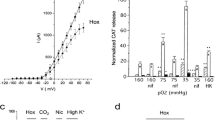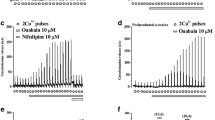Abstract
The adrenal medulla chromaffin cells (AMCs) secrete catecholamines in response to various types of stress. We examined the hypoxia-sensitivity of catecholamine secretion by rat foetal chromaffin cells in which the innervation by the splanchnic nerve is not established. The experiments were performed in primary cultured cells from two different ages of foetuses (F15 and F19). Membrane potential of AMCs was monitored with the patch clamp technique, and the catecholamine secretion was detected by amperometry. We found that: (1) AMCs from F19 foetuses showed hypoxia-induced catecholamine release. (2) This hypoxia-induced secretion is produced by membrane depolarization generated by an inhibition of Ca2+-activated K+ current [I K(Ca)] current. (3) Chromaffin precursor cells from F15 foetuses secrete catecholamine. The quantal release is calcium-dependent, but the size of the quantum is reduced. (4) In the precursor cells, a hypoxia-induced membrane hyperpolarization is originated by an ATP-sensitive K+ current [I K(ATP)] activation. (5) During the prenatal period, at F15, the percentage of the total outward current for I K(ATP) and I K(Ca) was 50 and 29.5%, respectively, whereas at F19, I K(ATP) is reduced to 14%, and I K(Ca) became 64% of the total current. We conclude that before birth, the age-dependent hypoxia response of chromaffin cells is modulated by the functional activity of KATP and KCa channels.





Similar content being viewed by others
References
Ashcroft FM, Gribble FM (1998) Correlating structure and function in ATP-sensitive K+ channels. Trends Neurosci 21(7):288–294 (Jul)
Ballanyi K (2004) Protective role of neuronal KATP channels in brain hypoxia. J Exp Biol 207(Pt 18):3201–3212 (Aug)
Bournaud R, Hidalgo J, Yu H, Jaimovich E, Shimahara T (2001) Low threshold T-type calcium current in rat embryonic chromaffin cells. J Physiol 537:35–44
Fearon IM, Thompson RJ, Samjoo I, Vollmer C, Doering LC, Nurse CA (2002) Sensitive K+ channels in immortalised rat chromaffin-cell-derived MAH cells. J Physiol 545(Pt 3):807–818 (15)
Inoue M, Fujishiro N, Imanaga I (1999) Na+ pump inhibition and non-selective cation channel activation by cyanide and anoxia in guinea-pig chromaffin cells. J Physiol 519(Pt 2):385–396
Jiang C, Haddad GG (1994) A direct mechanism for sensing low oxygen levels by central neurons. Proc Natl Acad Sci USA 91(15):7198–7201
Keating DJ, Rychkov GY, Roberts ML (2001) Oxygen sensitivity in the sheep adrenal medulla: role of SK channels. Am J Physiol Cell Physiol 281:C1434–C1441
Keating DJ, Rychkov GY, Adams MB, Holgert H, McMillen IC, Roberts ML (2004) Opioid receptor stimulation suppresses the adrenal medulla hypoxic response in sheep by actions on Ca(2+) and K(+) channels. J Physiol 555(Pt 2):489–502
Keating DJ, Rychkov GY, Giacomin P, Roberts ML (2005) Oxygen-sensing pathway for SK channels in the ovine adrenal medulla. Clin Exp Pharmacol Physiol 32(10):882–887
Kolski-Andreaco A, Tomita H, Shakkottai VG, Gutman GA, Cahalan MD, Gargus JJ, Chandy KG (2004) SK3-1C, a dominant-negative suppressor of SKCa and IKCa channels. J Biol Chem 279(8):6893–6904 (20)
Lee J, Lim W, Eun SY, Kim SJ, Kim J (2000) Inhibition of apamin-sensitive K+ current by hypoxia in adult rat adrenal chromaffin cells. Pflügers Arch 439:700–704
Lopez-Barneo J, Lopez-Lopez JR, Urena J, Gonzalez C (1988) Chemotransduction in the carotid body: K+ current modulated by PO2 in type I chemoreceptor cells. Science 241(4865):580–582 (Jul 29)
Lopez-Barneo J, Pardal R, Ortega-Saenz P (2001) Cellular mechanism of oxygen sensing. Annu Rev Physiol 63:259–287
Lopez-Barneo J (2003) Oxygen and glucose sensing by carotid body glomus cells. Curr Opin Neurobiol 13(4):493–499
Olver RE, Walters DV, M Wilson S (2004) Developmental regulation of lung liquid transport. Annu Rev Physiol 66:77–101
Mojet MH, Mills E, Duchen MR (1997) Hypoxia-induced catecholamine secretion in isolated newborn rat adrenal chromaffin cells is mimicked by inhibition of mitochondrial respiration. J Physiol 504(1):175–189
Murphy KP, Greenfield SA (1992) Neuronal selectivity of ATP-sensitive potassium channels in guinea-pig substantia nigra revealed by responses to anoxia. J Physiol 453:167–183
Peers C, Buckler KJ (1995) Transduction of chemostimuli by the type I carotid body cell. J Membr Biol 144(1):1–9
Seidler FJ, Slotkin TA (1985) Adrenomedullary function in the neonatal rat: responses to acute hypoxia. J Physiol 358:1–16
Seino S (1999) ATP-Sensitive potassium channels: a model of heteromeric potassium channel/receptor assemblies. Annu Rev Physiol 61:337–362
Slotkin TA, Seidler FJ (1988) Adrenomedullary catecholamine release in the foetus and newborn: secretory mechanisms and their role in stress and survival. J Dev Physiol 10:1–16
Stocker M (2004) Ca(2+)-activated K+ channels: molecular determinants and function of the SK family. Nat Rev Neurosci 5(10):758–770
Teitelman G, Baker H, Joh TH, Reis DJ (1979) Appearance of catecholamine-synthesizing enzymes during development of rat sympathetic nervous system: possible role of tissue environment. Proc Natl Acad Sci USA 76(1):509–513 (Jan)
Thompson RJ, Jackson A, Nurse CA (1997) Developmental loss of hypoxic chemosensitivity in rat adrenomedullary chromaffin cells. J Physiol 498:503–510
Thompson RJ, Nurse CA (1998) Anoxia differentially modulates multiple K+ currents and depolarizes neonatal rat adrenal chromaffin cells. J Physiol 512:421–434
Thompson RJ, Farragher SM, Cutz E, Nurse CA (2002) Developmental regulation of O(2) sensing in neonatal adrenal chromaffin cells from wild-type and NADPH-oxidase-deficient mice. Pflügers Arch 444(4):539–548
Thompson RJ (2004) Current understanding of the O2-signalling mechanism of adrenal chromaffin cells. In: Borges R, Gandia L (eds) Cell biology of the chromaffin cells, pp 95–106
Verhofstad AA, Hokfelt T, Goldstein M, Steinbusch HW, Joosten HW (1979) Appearance of tyrosine hydroxylase, aromatic amino-acid decarboxylase, dopamine beta-hydroxylase and phenylethanolamine N-methyltransferase during the ontogenesis of the adrenal medulla: an immunohistochemical study in the rat. Cell Tissue Res 200(1):1–13 (3)
Wightman RM, Jankowski JA, Kennedy RT, Kawagoe KT, Schroeder TJ, Leszczyszyn DJ, Near JA, Diliberto EJ Jr, Viveros OH (1991) Temporally resolved catecholamine spikes correspond to single vesicle release from individual chromaffin cells. Proc Natl Acad Sci USA 88(23):10754–10758 (Dec 1)
Williams SE, Wootton P, Mason HS, Bould J, Iles DE, Riccardi D, Peers C, Kemp PJ (2004) Hemoxygenase-2 is an oxygen sensor for a calcium-sensitive potassium channel. Science 306(5704):2093–2097
Wyatt CN, Buckler KJ (2004) The effect of mitochondrial inhibitors on membrane currents in isolated neonatal rat carotid body type I cells. J Physiol 556(1):175–191
Acknowledgement
The present study was partially supported by CONICYT-ECOS exchange program (CO3SO2) Confocal microscopy studies were performed on the facility on the CNRS Campus (Plate-forme Imagerie et Biologie Cellulaire) supported in part by the ASTRE program of the Conseil Général de l’Essonne.
Author information
Authors and Affiliations
Corresponding authors
Rights and permissions
About this article
Cite this article
Bournaud, R., Hidalgo, J., Yu, H. et al. Catecholamine secretion from rat foetal adrenal chromaffin cells and hypoxia sensitivity. Pflugers Arch - Eur J Physiol 454, 83–92 (2007). https://doi.org/10.1007/s00424-006-0185-z
Received:
Revised:
Accepted:
Published:
Issue Date:
DOI: https://doi.org/10.1007/s00424-006-0185-z




